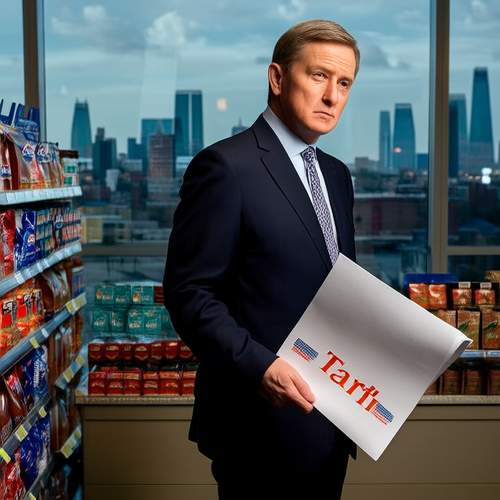Markets that had begun to stabilize in the face of lingering debt concerns were jolted back into turmoil on Friday as President Donald Trump reignited the trade war narrative with a series of provocative tariff threats. The Dow Jones Industrial Average closed lower by 256 points, or 0.61%, while the broader S&P 500 fell 0.67% and the tech-heavy Nasdaq Composite slid 1%. All three major indexes finished the week in the red, marking their worst performance in several weeks. The Dow and Nasdaq each posted their worst week in five weeks, while the S&P 500 experienced its worst week since early April.
The Tariff Threats and Market Reaction
The market downturn was triggered by Trump’s morning posts on Truth Social, where he threatened to impose a 25% tariff on Apple if the company refused to manufacture iPhones in the United States. Minutes later, he announced a potential 50% tariff on goods imported from the European Union. These threats sent shockwaves through the market, causing Dow futures to plummet as much as 600 points in the early hours of Friday.
Stocks opened sharply lower but managed to pare some losses throughout the day after Treasury Secretary Scott Bessent expressed optimism in a Bloomberg TV interview. Bessent anticipated “several large deals” in the coming weeks and suggested that US and Chinese officials would resume in-person trade negotiations following a temporary pause on higher tariff rates. However, the major indexes remained in the red as Trump later stated he was “not looking for a deal” with the EU.
The Impact on Wall Street and Beyond
The stark tariff threats, coupled with Bessent’s optimistic remarks, sent the CBOE Volatility Index (VIX) on a rollercoaster. The VIX, often referred to as Wall Street’s fear gauge, surged as much as 23% in the morning before settling with an 8% increase in the afternoon. The US dollar index, which measures the dollar’s strength against six major foreign currencies, slid 0.8%, marking its biggest single-day drop in a month and its worst week in six weeks. In contrast, gold, a traditional safe-haven asset during times of uncertainty, surged 2%.
Analysts’ Perspectives
Market analysts were quick to weigh in on the implications of Trump’s tariff threats. Rob Haworth, senior investment strategy director at US Bank Asset Management, noted that markets once again faced the fear of high tariffs on a major trading partner. Analysts at Barclays suggested that Trump’s social media posts about a 50% tariff on the EU were primarily negotiating tactics, but they acknowledged that the US had not moved past the tariff issue and that more trade policy volatility lay ahead.
David Doyle, head of economics at Macquarie, emphasized that the trade war was far from over and that tariffs remained a significant headwind for the US economy. Analysts at Citi echoed this sentiment, stating that the market did not approve of the tariff threats directed at Apple and the EU, highlighting a sense of déjà vu reminiscent of earlier tariff announcements.
The Broader Economic Context
In recent weeks, Wall Street had begun to shift its focus away from tariffs and toward Trump’s tax bill, which posed its own set of challenges for the markets. The temporary easing of trade tensions between the US and China in May, marked by a substantial reduction in tariffs, had somewhat alleviated investors’ concerns. However, Trump’s new threat of tariffs on the EU served as a stark reminder that policy uncertainty remained a significant factor.
The 90-day pause on most tariffs, set to end in July, has kept investors on edge, questioning the reliability of any announced pauses and further complicating the economic landscape. Investment strategist Ross Mayfield at Baird noted that this uncertainty would likely persist, with volatility remaining a key feature of the market.
The Impact on Specific Sectors
Apple, a major component of the S&P 500, was particularly hard hit by Trump’s tariff threats. The tech giant’s stock dropped 3% on Friday, contributing to its 22% decline this year. Apple’s market value fell back below the $3 trillion mark, reflecting the significant impact of the trade war on its business. The potential for higher tariffs on Apple products, should the company fail to shift manufacturing to the US, poses a significant risk to its profitability and market position.
The broader tech sector, already grappling with various challenges, also faced increased uncertainty. The Nasdaq Composite’s decline underscored the sector’s vulnerability to trade-related developments. Moreover, the impact of these tariff threats extends beyond the tech industry, affecting retirement plans like 401(k)s, which are often invested in funds tracking the S&P 500.
Global Market Reactions
The ripple effects of Trump’s tariff threats were felt globally. In Europe, markets tumbled after the announcement of potential higher tariffs on EU goods, with the benchmark STOXX 600 index falling 0.93%, Germany’s DAX dropping 1.54%, and France’s CAC index sliding 1.65%. The S&P 500 posted its fourth consecutive day of losses, stalling the recent rebound in US markets and leaving the benchmark index slightly down for the year.
Navigating Uncertainty
The resurgence of trade war concerns has once again plunged markets into a state of uncertainty, highlighting the ongoing challenges posed by policy volatility. While some market participants view Trump’s tariff threats as negotiating tactics, the reality is that these threats have real and immediate impacts on market sentiment and economic stability.
As investors navigate this uncertain landscape, the need for fiscal discipline and clear policy direction becomes increasingly evident. The coming weeks will be crucial in determining whether the US can move past the current trade impasse and find a path toward more stable economic relations with its trading partners. Until then, markets will likely remain on edge, with volatility persisting as a defining feature of the economic outlook.

By Grace Cox/May 26, 2025

By Emma Thompson/May 26, 2025

By Christopher Harris/May 26, 2025

By Laura Wilson/May 26, 2025

By Thomas Roberts/May 26, 2025

By Laura Wilson/May 26, 2025

By Amanda Phillips/May 26, 2025

By Noah Bell/May 26, 2025

By Laura Wilson/May 26, 2025

By John Smith/May 26, 2025

By Sarah Davis/May 26, 2025

By James Moore/May 26, 2025

By Amanda Phillips/May 26, 2025

By Michael Brown/May 26, 2025

By Daniel Scott/May 26, 2025

By Thomas Roberts/May 26, 2025

By Victoria Gonzalez/May 26, 2025

By Grace Cox/May 26, 2025

By Rebecca Stewart/May 26, 2025

By Laura Wilson/May 26, 2025